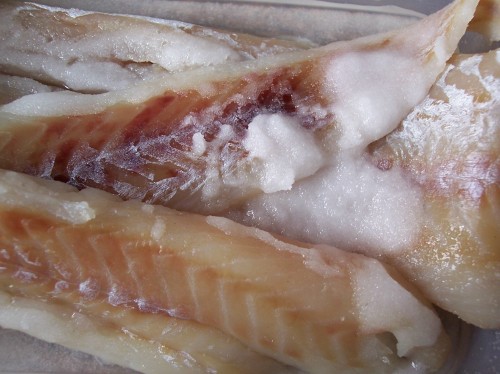Salt has been used as a method of preserving fish for centuries, prolonging its life and thus ensuring a ready supply. It is widely used in warmer countries where it would otherwise deteriorate very quickly. Nowadays fish is more commonly preserved by freezing, but the traditional dry salt method is still popular for the distinctive flavour it gives. Salted fish is not commonly used in traditional British cooking but is widely used across the world, especially in the Mediterranean, Scandinavia and the Caribbean so it is readily available in ethnic food shops, plus it can now often be found in the ethnic aisles of large supermarkets. I regularly buy blocks of salted skinned boneless pollack for using in recipes such as Hyacinth’s Salt Fish Cakes from the Caribbean or Spanish/Basque Style Salt Cod (Bacalao) in Spicy Tomato Sauce. Providing it is thoroughly soaked (overnight) and rinsed in two or three changes of water I find this purchased ready salted fish easy to use. Providing the expiry date on the pack is observed, it does not need refrigeration. (It can eventually be frozen too if it looks as if it might go out of date before use.)
When my mother in law gave me her copy of Taste of the Sea by Rick Stein I was surprised to see just how easily fish, particularly white fish, can be salted at home. I experimented with reasonable success with some thawed frozen skinless pollack fillets, just enough for one meal. The instructions are not clear on how salted fish should be kept for long term use, (the recipe suggested it could be stored for up to week but I was nervous about keeping it for that long) so I used the fish just two days into the salting process. (I also assumed that it needed to be refrigerated until use, even though I store purchased fish in the cupboard.) It was lightly cured and soft to the touch with a mildly salted flavour but did not have a dried texture (this might have happened with longer salting). This method of salting is simple, but I feel it is worth noting here that it should probably be called lightly salted fish. After some research I discovered a helpful article at Downhomelife which started with a warning:
Proper salting is a lengthy, fairly complicated process and special equipment or controlled conditions are needed to dry the fish thoroughly and safely.
Which is worth bearing in mind, though these words have now been removed from the article. However the warning is about drying the fish to avoid poor results. On the plus side the site also mentions the simple shortened method I had tried:
…the fish is cured in salt in what’s called a “pound” – a square bin where you let the fish soak in salt for about 21 days. If you want a less salty version called “shore fish,” you lightly sprinkle the fish with salt and let it cure for only a couple days.
I would certainly not re-freeze fish salted by this method as I am not sure enough that this can be done safely. If salting fresh fish, rather than frozen, it could be frozen once salted. Below is my version of salted fish. My picture was taken 24hrs after salting. In the end I consider this a simple way of lightly salting fish, providing the process takes place two days ahead of the date the fish is required. It is a method I would be happy to use again, especially as I prefer the milder flavour, but I will probably also continue to buy the blocks of salted fish as they are so convenient. Other useful links are this overview of Salt fish giving a helpful list of types and names around the world, this article at ehow with a similar method to that given by Rick Stein and this enlightening Ezine Article. I would be interested to hear from any readers who have successfully tried salting fish at home by the Rick Stein method, or similar.
If you have not smelled salt fish then you would be advised to do so before you make your own to give a guideline. Salt fish has a different, much stronger, aroma from fresh fish but if really unpleasant then discard the fish and do not take the risk. Often purchased salt fish smells particularly strong but we have never suffered ill effects.

'Meanderings through my Cookbook' http://www.hopeeternalcookbook.wordpress.com
Salted Fish
Fillets of White Fish (Cod, Haddock, Pollack, Coley or similar)
Salt (Type not specified in the original – I used Rock Salt)
A large plastic container big enough to hold the fish without overlapping
1. If using frozen fish then it should be thoroughly defrosted before salting and should not be re-frozen.
2. Pat the fish fillets dry with kitchen paper and put them in the plastic container in a single layer without overlapping.
3. Completely cover the fish with a thick layer of salt.
4. Put a cover on the container and refrigerate for 24hours.
5. After 24hours most of the salt will have turned to brine with the water drawn out of the fish.
6. This fish will now be sufficiently preserved to keep for up to a week in the refrigerator. The recipe does not say what to do with the brine but I poured away the excess liquid, leaving the patches of undissolved salt to continue the process.
—–
To prepare salt fish for cooking it should be soaked in plenty of cold water. If it is lightly salted this will take just an hour or two but fish that is more dried out should be soaked for up to 24hours. I usually give it a second quick rinse in cold water before use.






 Search Food Blogs
Search Food Blogs 

